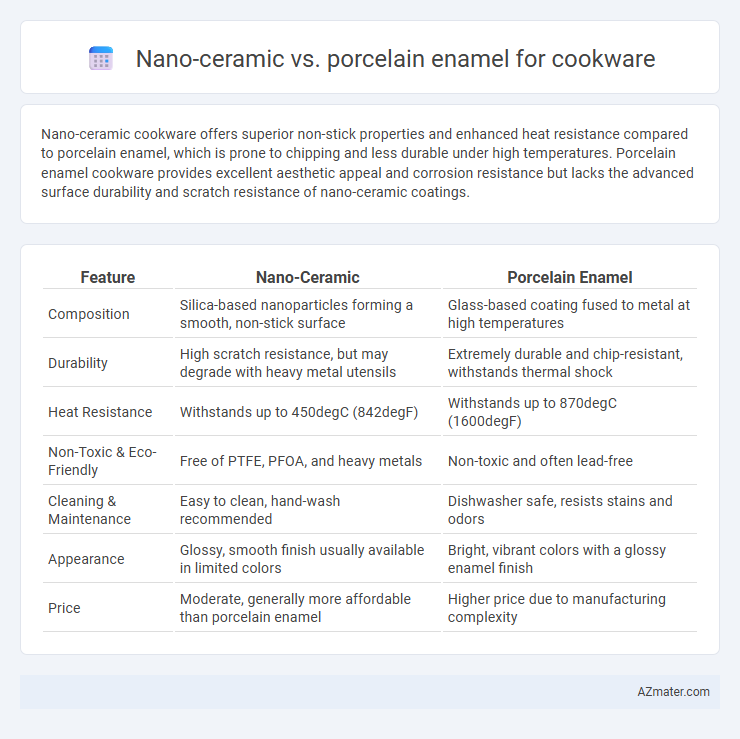Nano-ceramic cookware offers superior non-stick properties and enhanced heat resistance compared to porcelain enamel, which is prone to chipping and less durable under high temperatures. Porcelain enamel cookware provides excellent aesthetic appeal and corrosion resistance but lacks the advanced surface durability and scratch resistance of nano-ceramic coatings.
Table of Comparison
| Feature | Nano-Ceramic | Porcelain Enamel |
|---|---|---|
| Composition | Silica-based nanoparticles forming a smooth, non-stick surface | Glass-based coating fused to metal at high temperatures |
| Durability | High scratch resistance, but may degrade with heavy metal utensils | Extremely durable and chip-resistant, withstands thermal shock |
| Heat Resistance | Withstands up to 450degC (842degF) | Withstands up to 870degC (1600degF) |
| Non-Toxic & Eco-Friendly | Free of PTFE, PFOA, and heavy metals | Non-toxic and often lead-free |
| Cleaning & Maintenance | Easy to clean, hand-wash recommended | Dishwasher safe, resists stains and odors |
| Appearance | Glossy, smooth finish usually available in limited colors | Bright, vibrant colors with a glossy enamel finish |
| Price | Moderate, generally more affordable than porcelain enamel | Higher price due to manufacturing complexity |
Introduction to Nano-ceramic and Porcelain Enamel Cookware
Nano-ceramic cookware features an advanced non-stick coating composed of nanoparticles that enhance durability, heat resistance, and scratch resistance, making it a safer and eco-friendly option free from PTFE and PFOA chemicals. Porcelain enamel cookware is characterized by a glass-like coating fused to metal at high temperatures, offering excellent heat retention, resistance to acidic foods, and a non-reactive, easy-to-clean surface that prevents rusting. Both materials provide superior cooking performance, with nano-ceramic emphasizing a modern, toxin-free non-stick surface and porcelain enamel focusing on traditional, robust enamel-coated metal construction.
Material Composition: Nano-ceramic vs Porcelain Enamel
Nano-ceramic cookware features a coating composed of silica-based nanoparticles combined with ceramic materials, which creates a non-reactive and highly durable surface resistant to scratches and high temperatures. Porcelain enamel consists of a glassy, vitreous coating made by fusing powdered glass onto metal at extreme heat, providing exceptional resistance to corrosion and chemical reactivity. Both materials offer durable, non-stick properties, but nano-ceramic emphasizes advanced nanoparticle technology for enhanced heat distribution, while porcelain enamel focuses on a robust glass coating for long-lasting surface protection.
Nonstick Properties and Cooking Performance
Nano-ceramic cookware offers superior nonstick properties with a coating infused with nanoparticles that enhance scratch resistance and durability, ensuring smooth food release and easy cleaning. Porcelain enamel features a hard, glass-like surface that resists staining and corrosion but may have less effective nonstick performance compared to nano-ceramic coatings. In cooking performance, nano-ceramic distributes heat evenly and efficiently, while porcelain enamel excels in heat retention, making each suitable for different culinary techniques.
Durability and Scratch Resistance
Nano-ceramic cookware offers superior scratch resistance due to its advanced nanoparticle-infused coating, providing enhanced durability compared to traditional surfaces. Porcelain enamel, while durable and resistant to high temperatures, is more prone to chipping and cracking under impact or heavy use. The nano-ceramic coating maintains its integrity longer, making it ideal for everyday cookware subjected to rigorous handling.
Heat Distribution and Retention
Nano-ceramic cookware offers superior heat distribution due to its advanced nanotechnology particles, ensuring even cooking and minimizing hot spots. Porcelain enamel, while visually appealing and resistant to staining, tends to retain heat longer but may have less uniform heat dispersion compared to nano-ceramic coatings. The enhanced thermal conductivity of nano-ceramic surfaces delivers more consistent temperature control, ideal for precise cooking applications.
Safety and Toxicity Concerns
Nano-ceramic cookware features a non-toxic, PTFE and PFOA-free coating, offering a safer alternative with reduced risk of harmful chemical release at high temperatures. Porcelain enamel cookware, made from fused glass and typically free from heavy metals like lead and cadmium, provides a durable surface with negligible toxicity but can chip, potentially exposing underlying metal. Both materials minimize toxic risks compared to traditional non-stick coatings, but nano-ceramic excels in chemical safety while porcelain enamel emphasizes durability and inertness.
Cleaning and Maintenance Requirements
Nano-ceramic cookware features a non-porous, highly durable surface that resists staining and requires minimal effort for cleaning, often needing only mild soap and water. Porcelain enamel cookware, while aesthetically appealing, can be prone to chipping and cracking, demanding careful handling and hand washing to maintain its glossy finish and avoid damage. Both materials benefit from non-abrasive cleaning tools, but nano-ceramic's superior resistance to residue buildup makes it generally easier to maintain over time.
Aesthetics and Design Options
Nano-ceramic cookware offers a sleek, modern appearance with vibrant, customizable color options and a smooth, glossy finish that resists chipping and scratching. Porcelain enamel cookware showcases a timeless, classic aesthetic with a glossy, glass-like surface available in a wide range of rich colors and intricate patterns, often inspired by traditional designs. Both materials provide durable, visually appealing options, but nano-ceramic's advanced coating allows for more contemporary styles while porcelain enamel emphasizes vintage charm and elaborate detailing.
Cost Comparison and Value for Money
Nano-ceramic cookware typically costs more upfront than porcelain enamel but offers superior non-stick properties and greater scratch resistance, resulting in longer-lasting durability. Porcelain enamel is generally more affordable and provides excellent heat retention and even cooking but may chip more easily, reducing its lifespan. Evaluating overall value for money, nano-ceramic's higher initial price is offset by extended usability and reduced replacement frequency, making it a cost-effective choice for frequent cooks.
Which is Better: Nano-ceramic or Porcelain Enamel?
Nano-ceramic cookware offers superior non-stick properties and higher resistance to thermal shock compared to porcelain enamel, making it ideal for everyday cooking and easy maintenance. Porcelain enamel excels in durability and aesthetic appeal, with a thick, glass-like coating that resists chipping and scratching but can be prone to discoloration over time. Choosing between nano-ceramic and porcelain enamel depends on preferences for non-stick performance versus long-term durability and design.

Infographic: Nano-ceramic vs Porcelain enamel for Cookware
 azmater.com
azmater.com